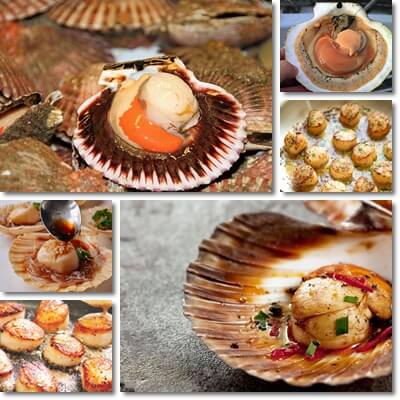Sea scallops, or simply scallops, are a species of saltwater mollusks and a popular seafood. Scallops are a longevous species, living up to 20 years. If allowed to, they can reach substantial sizes and grow bigger than other mollusks like clams or mussels. They are free living, swimming over short distances propelled by clapping the two parts of their shell together. From a nutritional point of view, scallops are a source of essential Omega-3 fatty acids and vitamin B12 and provide important amounts of quality protein.
Most scallops that end up on our tables are harvested directly from the wild, scooped up with dredges from the seabed where they reside. However, despite being a sustainable marine food source, their numbers have diminished considerably over the years which has lead to the increase in popularity of scallop fisheries where scallops are farmed for commercial purposes. Moreover, the current methods employed for mass-harvesting are seeing competition from direct, hand-harvesting which targets scallops and other mollusks exclusively, without inadvertently collecting other species or damaging the seabed plant life. The species holds benefits for the marine environment because they filter seawater and are an important part of the marine ecosystem, maintaining a crucial balance.

What do scallops look like? Scallops are bivalve mollusks, meaning their shell is made up of two almost identical parts called valves which are joined together at one edge by a flexible connective tissue. The distinctive feature of scallops is their fan-shaped smooth shell with smooth edges and long furrows radiating from the junction point of the two parts of the shell. Scallops and their relatives, clams, have the most symmetrical shells, compared to oysters which are the least symmetrical. Most specimens are relatively large, reaching 10 cm in diameter or more, like the Mediterranean scallop (Pecten jacobaeus).
Scallops shells are either off white with grey or pale brown colors or vividly colored in different shades of reddish orange, bright orange, pink or pastel mauve. Some species have different patterns on their shells. Scallops can be eaten both raw and cooked and have two different edible parts:
1) The scallop, which is the abductor muscle, a firm, off-white-colored, cylindrical piece of meat.
2) The coral, a bright, red-orange colored, mushy-looking meat consisting of the scallop eggs.
The rest of the internal organs found within the scallop shell are discarded.
What do scallops taste like raw and cooked? The white meat called the scallop has a soft, slightly chewy texture and an overall mild, delicately sweet taste with subtle fishy flavors, but not briny. Cooked scallop has a firm, but tender texture and tastes like crab meat or shrimp. Because of its mild, almost neutral aroma, it tends to absorb flavors when cooked. Overcooking causes scallop meat to become chewy like rubber. The raw coral has a soft, mushy texture and a rich, but slightly fishy, briny taste. To me, scallop roe is like raw liver. Because of its slimy texture, most of the time only the white meat is served in the scallop.

Are scallops healthy?
Scallops as seafood are in great demand all over the world and highly appreciated both for their health benefits and good-tasting meat. Both the white and coral meat boast the following nutritional values:
1) Source of Omega-3. Scallops are a good source of healthy Omega-3 fatty acids, with the roe containing more than the white meat. Omega-3 fatty acids have powerful antioxidant and anti-inflammatory properties and boast cholesterol-lowering and anti-hypertensive properties. Moreover, scallops are an excellent brain food.
Omega-3 nourish the brain and help maintain cognitive health with benefits on memory and learning. Because of their good content of the healthy fatty acid, scallops are good for brain fog and help reduce mental fatigue and foggy thinking (read more about brain fog).
2) Rich in protein. 100 g of scallops contains anywhere from 12 to 20 g of protein/100 g. This makes them a protein-rich food, good for muscle growth and repairing damaged muscle fibers. The amino acids that make up protein are also brain food and help synthesize neurotransmitters that regulate appetite, sleep and mood. Eating high-protein foods like scallops can have great benefits for mood, improving disposition and potentially helping reduce anxiety.
3) Contains vitamin B12. Both raw and cooked scallops have around 1.4 to 2.1 micrograms of vitamin B12 representing an estimate of 50-90% of the current RDA of the nutrient. Vitamin B12 is good for nerve health, helping preserve the protective myelin sheath covering the tail of nerve cells. A deficiency has been linked with increased risks of developing Alzheimer’s disease, Parkinson, multiple sclerosis and other degenerative diseases of the nervous system.
Moreover, vitamin B12 is essential for pregnant women because it ensures the good development of babies in the womb and helps prevent neural tube defects of brain, spine and spinal cord in newborn babies.
4) Low fat and calorie content. 100 g of scallops contains between 70 and 110 kcal and less than 1% fat, making them good for cardiovascular health and weight loss. As a general rule, most high-protein foods are also relatively low in calories and thus great to eat for when you’re trying to lose weight.
5) Contain phosphorus, potassium and sodium in good amounts. Phosphorus contributes to good bone density, while potassium regulates blood pressure and counteracts the side effects of too much sodium. As for sodium, it is vital for good health, but only in limited amounts (no more than 2,300 mg a day, according to the new Reference Daily Intakes of vitamins and minerals. Other vitamins and minerals in scallops include small amounts of vitamins B1, B2, B3, B6 and B9, calcium, iron, magnesium and zinc. Below is a beautiful video of scallops swimming on the seafloor by clapping their shells together:
Side effects and health risks
Here are the most likely dangers of eating scallops:
1) Allergic risk. Scallops can be a source of allergic reactions in those with seafood allergies. Symptoms of an allergic reaction include headaches, tingling tongue, sweating, low blood pressure, swelling of the tongue, breathing problems, skin symptoms such as a rash and can culminate with anaphylactic shock.
If you have known seafood allergies or suspect you might be allergic, avoid eating all types of seafood. In addition to scallops, shrimp, crab, oysters and other mollusks as well as different types of fish can trigger allergic reactions. If you experience allergy symptoms after eating seafood, seek medical help immediately.
2) Scallops food poisoning. If they are not fresh, scallops can cause food poisoning. Also, because they filter seawater, they may be carriers of pathogenic bacteria, fungi and other potentially dangerous microorganisms. It is recommended to avoid eating raw seafood and always cook scallops to destroy potential bacteria.
How to eat scallops
Most people prefer eating scallops raw, with a little butter or lemon juice for flavor. However, because raw seafood poses certain health risks, it is recommended to always cook scallops. Grilling, roasting, steaming or any cooking method can be employed and, as long as they are not cooked for too long, scallops will preserve their tenderness and delicately sweet flavor. Various herbs and spices may be uses, from pepper, wasabi and ginger to lemon juice, olive oil and others. Fortunately, both raw and cooked scallops preserve their nutritional value and health benefits.
